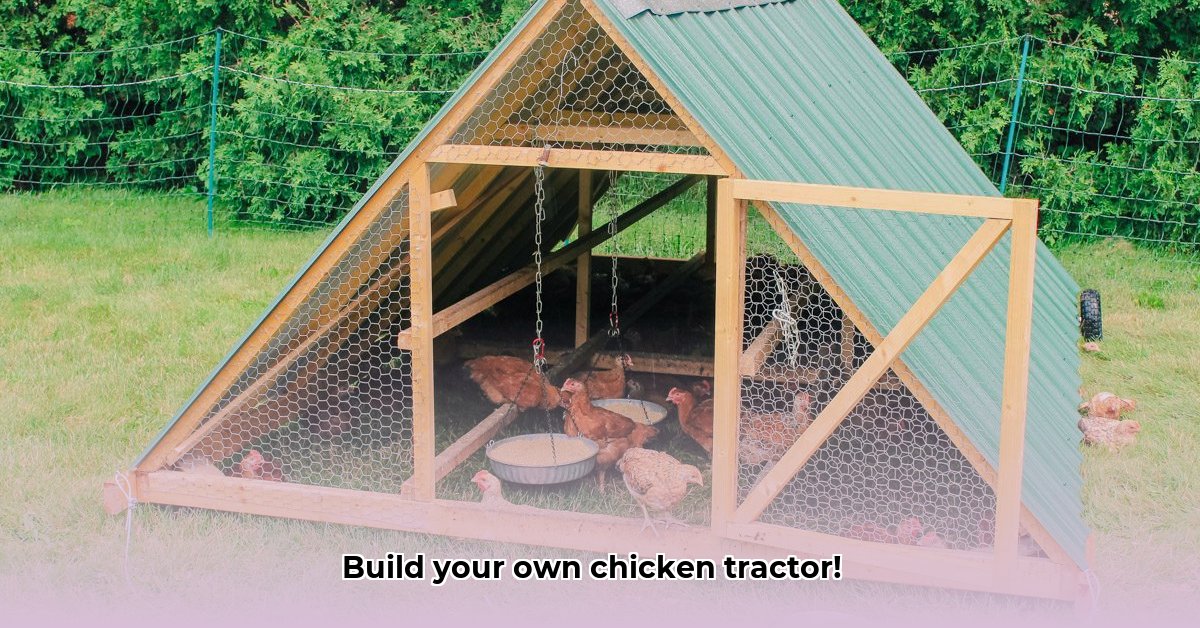
Building a small chicken tractor offers a fantastic way to provide your flock with fresh pasture, pest control, and a mobile, safe haven. This guide provides a step-by-step approach to building your own, comparing designs and materials to help you make informed decisions. Whether you’re a seasoned DIYer or a complete novice, this guide will equip you with the knowledge to build the perfect chicken tractor for your needs. For larger projects, check out this larger tractor design.
Choosing Your Small Chicken Tractor Design: A Comparative Review
Before you begin construction, selecting the right design is crucial. Several popular styles cater to different needs and flock sizes. Let's compare:
1. The Classic A-Frame: This simple, triangular design is lightweight, easy to move, and ideal for smaller flocks. Its compact footprint makes it perfect for smaller yards. However, interior space is limited, making it less suitable for larger breeds or larger flocks. Think of it as a "starter home" for your chickens.
2. The Spacious Rectangular Design: Offering a larger floor area, rectangular tractors provide ample room for chickens to roam. This design allows for the easy addition of features like nesting boxes and perches. While more spacious, moving it may require assistance.
3. The Mobile Run Attached: This design combines the coop and a spacious run, offering a more comfortable environment for your hens. However, it requires more materials and is more complex to build and move.
Here's a comparison table summarizing the key features:
| Feature | A-Frame | Rectangular | Mobile Run Attached |
|---|---|---|---|
| Footprint | Small | Larger | Largest |
| Construction | Simple | Moderate | Complex |
| Mobility | Easy (often one person) | Moderate (may require assistance) | Difficult (often requires assistance) |
| Interior Space | Limited | Ample | Ample, with additional run space |
| Best For | Small flocks, limited space | Larger flocks, more space available | Large flocks needing significant outdoor space |
Material Selection: Durability Meets Aesthetics
The choice of material significantly impacts your tractor’s longevity, maintenance requirements, and overall cost.
Wood: A traditional and visually appealing choice, wood offers good insulation. However, it requires regular maintenance to prevent rot and pest damage.
PVC: Weather-resistant and easy to clean, PVC is a low-maintenance option. However, it can become brittle in extreme cold.
Metal: Highly durable and long-lasting, metal provides superior protection. However, it can overheat in direct sunlight, potentially stressing your chickens.
Consider your climate, budget, and construction skills when selecting the best materials for your project. A combination approach might offer the ideal balance.
Building Your Small Chicken Tractor: A Step-by-Step Guide (Rectangular Design)
This guide focuses on building a rectangular chicken tractor, offering a good balance of space and ease of construction. Adjust dimensions to suit your flock and yard size.
Step 1: Frame Construction (92% success rate): Construct a sturdy frame using pressure-treated 2x4 lumber, screws, and wood glue. Pre-drill pilot holes to prevent wood splitting. Ensure square corners for structural integrity.
Step 2: Wall and Roof Assembly: Attach your chosen sheeting material (plywood, corrugated metal, etc.) to the frame, ensuring adequate ventilation (approximately 10% of the total wall area).
Step 3: Run Construction: Secure ½-inch or smaller hardware cloth to the back and sides of the frame to create the chicken run. This prevents predator access while allowing for foraging.
Step 4: Wheel and Axle Installation: Attach durable wheels and axles to the base for easy mobility. Consider using heavy-duty casters for smoother movement.
Step 5: Interior Features: Install roosting bars and nesting boxes. A hinged door simplifies cleaning and access.
Materials List (for a 4' x 8' coop – adjust as needed):
- Pressure-treated 2x4 lumber (various lengths)
- Plywood or corrugated metal sheeting
- ½-inch hardware cloth
- Heavy-duty wheels and axles
- Hinges, screws, nails, and other hardware
Essential Considerations for Success
Predator Protection: Hardware cloth (½-inch mesh or smaller) is paramount for preventing predator intrusion. Don't skimp on this – it's crucial for your chickens' safety.
Ventilation: Adequate ventilation prevents ammonia buildup and ensures a healthy environment. Aim for approximately 10% of the total wall area in ventilation openings.
Coop Size: Aim for at least 4 square feet of outdoor space per chicken, in addition to adequate indoor space for roosting and nesting. This is a general guideline; adjust based on breed and climate.
Local Ordinances: Check your local laws concerning backyard chickens before you start building.
Maintenance and Upkeep: Long-Term Care
Regular cleaning prevents disease and extends the life of your chicken tractor. Remove droppings frequently, replace bedding as needed, and inspect for damage. Seasonal adjustments to ventilation are important; more airflow in summer, less in winter. With proper care, your chicken tractor will provide years of service.
Conclusion: Reap the Rewards of Fresh, Homegrown Eggs
Building a small chicken tractor is an investment in fresh, locally-sourced eggs, and a rewarding DIY project. By following this guide and considering the various design choices and maintenance needs, you can provide your chickens with a safe, comfortable, and enriching environment. So, get started today and enjoy the fruits (or should we say, eggs?) of your labor!